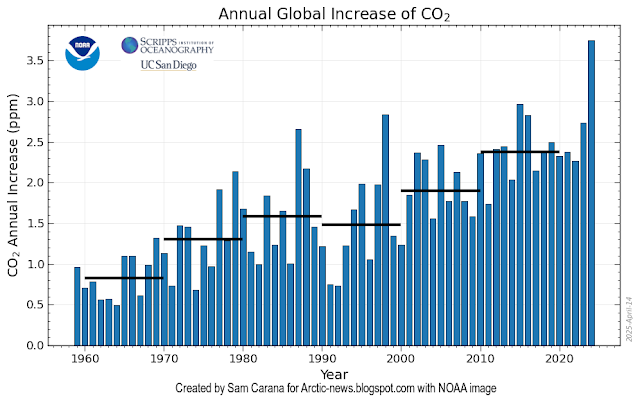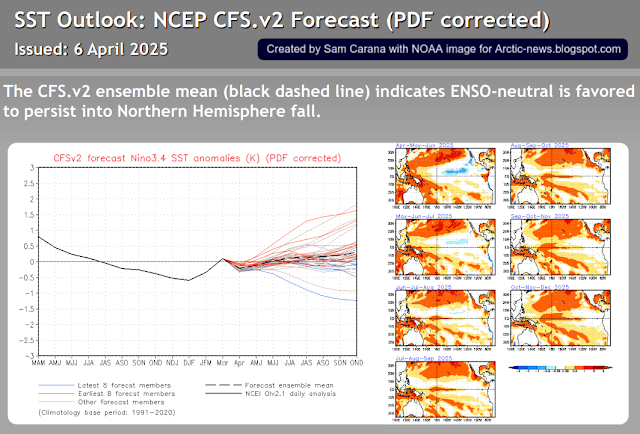Carbon dioxide (CO₂) concentrations grew by 3.75 parts per million (ppm) during 2024, the highest growth rate on record.
The annual global average surface concentration of CO₂ for 2024 was 422.79 ppm, according to NOAA data. The image below shows monthly global average surface concentrations of CO₂.
 |
| [ image from earlier post, click on images to enlarge ] |
 |
| [ from earlier post ] |
 |
| [ Arctic temperature anomaly in 2100 ] |
There are several points indicating that the CMIP6 SSP585 anomalies may be too conservative, as discussed before and below. One point is that different base periods are used in above images, but none of them is pre-industrial. When using a genuinely pre-industrial base, the global temperature rise will be higher. Using different bases can make a difference of more than 1°C. A higher historic rise means stronger feedbacks, e.g. that there will be more water vapor in the atmosphere.
In a CMIP6 SSP585 scenario, temperatures are projected to keep rising beyond 2100, as illustrated by the image below, from a 2016 analysis by Brian O'Neill et al.
Importantly, the GWP of the non-CO₂ gases and aerosols can be very high over a short horizon, which means that rises in their concentrations can result in a huge and rapid temperature rise. Two of them, nethane and nitrous oxide, are discussed below in more detail.
 |
| [ from earlier post, also note the recent discussion on monthly methane ] |
 |
| [ from earlier post ] |
Large increases in N₂O emissions could occur and since N₂O is a potent greenhouse gas with a long lifetime, the impact would accumulate rapidly and the rise could follow a steep curve, the more so since N₂O emissions caused by people come mainly from applying nitrogen fertilizers and animal waste to farmland and pastures, and policy control over emissions from nitrogen fertilizers is largely absent or ineffective, while farmers are increasingly using nitrogen fertilizers in efforts to increase crop yield, especially where yields are falling due to rising temperatures and more extreme weather events. IPCC AR6 gives N₂O a global warming potential (GWP) of 273 over both 500 years and 100 years, and of 118 over 20 years, while its lifetime is 120 years.
 |
| [ from earlier post ] |
Such short-term variables are smoothed out in the black linear trend which shows a steady but much slower rise of 0.5°C over about 3½ years (Jan 2023 - Sep 2026), and this rise is a much steeper rise than the 1.1°C rise over 81 years (from 1941 to 2022) of a linear trend in the image below, from an earlier image.
A fourth point indicating that the above anomalies could be conservative is that, as the images below show, very high anomalies are already now showing up over the Arctic Ocean. The Arctic is hit most strongly by the temperature rise, as illustrated by the image below showing the ERA5 global temperature anomaly for February-March 2025 versus 1951-1980.
The fact that these air temperature anomalies occurred at a time of year when little or no sunlight was yet reaching the Arctic indicates the strong contribution of ocean heat to these high air temperature anomalies.
 |
| [ Gulf Stream, click to enlarge ] |
 |
| [ Arctic sea ice volume, click to enlarge ] |
 |
| [ from the Extinction page ] |
 |
| [ from earlier post ] |
Meanwhile, the IPCC persists in downplaying the potential for dangerous developments in efforts to hide the need for the most effective climate action. The IPCC keeps pointing at less effective policies such as support for BECCS and biofuel, while continuing to make it look as if there was a carbon budget to divide among polluters, as if polluters could continue to pollute for decades to come, as discussed in many earlier posts such as this one, this one and this one.
Links
https://gml.noaa.gov/webdata/ccgg/trends/co2/co2_annmean_gl.txt
• NOAA - Annual Mean Global Carbon Dioxide Growth Rates
discussed on facebook at:
https://www.facebook.com/groups/arcticnews/posts/10162561012229679
• Climate Reanalyzer
https://climatereanalyzer.org
• The Scenario Model Intercomparison Project (ScenarioMIP) for CMIP6 - by Brian O'Neill et al. (2016)
https://gmd.copernicus.org/articles/9/3461/2016
• IPCC - warming in 2010–2019 relative to 1850–1900
https://www.ipcc.ch/report/ar6/wg1/figures/summary-for-policymakers/figure-spm-2
• NOAA - Nitrous oxide emissions grew 40 percent from 1980 to 2020, accelerating climate change
• N₂O is currently the most significant ozone-depleting substance being emitted
• Copernicus
https://climate.copernicus.eu
• NOAA - ENSO: Recent Evolution, Current Status and Predictions - 14 April 2025
https://www.cpc.ncep.noaa.gov/products/analysis_monitoring/lanina/enso_evolution-status-fcsts-web.pdf
• Danish Meteorological Institute - Arctic sea ice volume and thickness
https://ocean.dmi.dk/arctic/icethickness/thk.uk.php
• Transforming Society
https://arctic-news.blogspot.com/2022/10/transforming-society.html
• Climate Plan
https://arctic-news.blogspot.com/p/climateplan.html
• Climate Emergency Declaration
https://arctic-news.blogspot.com/p/climate-emergency-declaration.html









.png)




























